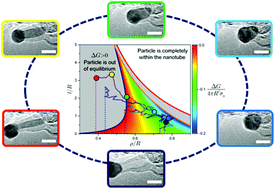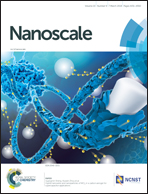Metastable morphological states of catalytic nanoparticles†
Abstract
During the catalytic synthesis of graphene, nanotubes, fibers, and other nanostructures, many intriguing phenomena occur, such as phase separation, precipitation, and analogs of capillary action. Here, we demonstrate, using in situ, real-time transmission electron microscope imaging and modeling, that the catalytic nanoparticles display functional, metastable states, reminiscent of some protein ensembles in vivo. As a carbon nanostructure grows, the nanoparticle elongates due to an energetically favorable metal–carbon interaction that overrides the surface energy increase of the metal. The formation of subsequent nested tubes, however, drives up the particle's free energy, but the particle remains trapped until an accessible free energy surface allows it to exit the tube. During this time, the nanoparticle continues to catalyze tube growth internally to the nested structure. This universal nonequilibrium thermodynamic cycle of elongation and retraction is heavily influenced by tapering of the structure, which, ultimately, determines the final product and catalyst lifetime. Our results provide a unifying framework to interpret similar phenomena for other catalytic reactions, such as during CO oxidation and boron nitride tube growth, and suggest routes to the practical optimization of such processes.



 Please wait while we load your content...
Please wait while we load your content...